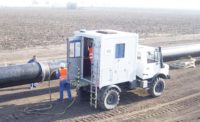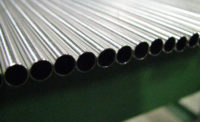The technology, called Photon Induced Positron Annihilation (PIPA), was invented by scientists at the U.S. Department of Energy's Idaho National Engineering and Environmental Laboratory (Boise, ID) and licensed to Positron Systems Inc. (Boise) for commercial use.
PIPA can detect component fatigue and embrittlement of materials based on the amount of energy created when positrons and electrons annihilate each other. The technology can identify defective materials or determine the remaining "life" of materials. It can identify atomic lattice defects smaller than 10 microns in size and measurement uncertainties of less than 1%.
Measurements using this technique have been performed on a variety of materials, including titanium, aluminum, stainless steel, iron, copper, polymers and composites. The system can penetrate materials to different depths depending on the material's density. For example, it can penetrate 2 inches into stainless steel, 3.5 inches into titanium and 4 inches into aluminum, says Curt Rideout, chemical and nuclear engineer who serves as Positron's military marketing and sales manager.
If desirable, measurements can be taken from both sides of a test material or part, doubling the depth-detection capability. The technology can also produce cross-sectional analyses, and assembled parts can be tested and analyzed. For instance, a titanium strut inside of an aluminum airplane wing can be tested without having to disassemble the structure.
No scraping required
"Because we generate the positrons deep within the material, we are not surface limited," says Rideout. "You don't need to scrape the paint or worry about rust or corrosion. We go through all of that with X-rays."
PIPA works by penetrating materials with a photon beam. This generates positrons inside the material or component being examined. The positrons come in contact with free electrons within the material, and the result is annihilation of those positrons and electrons. The annihilation produces gamma rays, and this energy can then be measured, revealing defects or damage that can be nondestructively located and characterized with high accuracy, the company says. The technology can also be used to project the remaining life spans of the materials tested.
Because the PIPA technology incorporates radiation, the government requires that operators must have radiation worker training. "It is like any other operation. If you light up a hanger with a radiography source such as an X-ray, you have to clear the hanger," says Rideout. "We have the same requirements. To ensure safety, we have an automatic shutdown laser fence."
Positron Systems offers several ways for manufacturers to access the technology. Positron will act as an outsourcing company accepting material coupons for testing at its Lab Based Test and Analysis Center or it will sublicense the technology to others. Positron Systems charges about $5,000 an hour for its PIPA testing service, but testing times can often be relatively brief. "A company may send us five coupons and we can light up those sources in 30 seconds and read them in five minutes and the actual cost of the beam time is a lot less," says Rideout.
One ton portables
The PIPA system is located at Positron Systems' Lab Based Test and Analysis Center at Idaho State University (Boise). The PIPA unit fits in a 10- by 10-foot room, but the company is currently developing a portable unit that is expected to be available in 2002. The mobile unit will measure 3 by 6 feet, weigh almost a ton and will be designed for truck transport on skids. It will cost around $3 million to $5 million. "That is a lot of money, but if you figure that one aircraft engine on a 747 is $6 million and we can help prevent the aircraft engine from eating itself, then it has paid for the price of the unit there," says Rideout. "And, it doesn't just do a single application. It can test aircraft engines and fan disks and then immediately test landing struts. Instead of buying four different pieces of equipment, this one unit does it all."
TECHNOLOGY CONTACT
For more information on Photon Induced Positron Annihilation technology, contact:
Positron Systems Inc.
6151 N. Discovery Way
Boise, ID 83713
(208) 672-1923
Fax: (208) 672-8012
URL: wwwpositronsystems.com
QUALITY SPECS
- Identify atomic lattice defects that are less than 10 microns in size
- Measurement uncertainties of less than 1%
- Detection at depths up to 4 inches
- Depending on ease of access, measurements can be taken from both sides (doubling the depth-detection capability)
- Cross-sectional analysis
- Assess lattice damage at less than 1% fatigue.
How the Process Works
Testing with positrons is not a new technique. These particles were first discovered in the 1920s and have been used in surface defect detection for some 30 years, according to Curt Rideout, military marketing and sales manager for Positron Systems Inc. (Boise, ID).
Testing with positrons has until now been limited to surface analysis, because the particles cannot penetrate more than 1 millimeter deep. The Photon Induced Positron Annihilation (PIPA) technology developed by the Department of Energy overcomes that limitation.
Using PIPA, Positron Systems is able to induce the creation of positrons inside a material being tested by injecting the material with a high-energy photon beam. The energy from the beam excites atoms within the material, and the energy causes neutrons--among the building blocks of atoms--to be ejected from the atoms. Without the neutrons, the atoms become unstable and decay rapidly, kicking off positrons in the process.
Positrons are like something out of a Star Trek episode; they are the antimatter to an electron's matter. Positrons are positively charged, subatomic particles that are equal, but opposite, in mass and magnitude of charge to negatively charged electrons.
In a material that has no defects, the positrons and free electrons that are generated naturally within the material seek each other out--due to their opposite charges--and both are annihilated when they collide. This produces energy in the form of gamma radiation.
In a material that has defects in the atomic lattice structure, the process is slightly different. In this case, the positrons are drawn to the voids caused by the damage in the structure, as a way to "escape," or get as far away as possible from the positively charged protons within the atoms of the material. Once within the lattice defects, the momentum of the positrons is reduced, as they are essentially held in place by their positive charges. In effect, this makes them sitting ducks for the free electrons, which eventually find the positrons within the voids, producing the same energy producing collision and annihilation scenario.
PIPA works by using gamma spectrometry to measure and analyze the level of gamma radiation released by the annihilations. Scientists know that the amount of energy released by the annihilation itself is 511 kiloelectronvolts (KeV), or 2 gammas. But when positrons and electrons collide, the total energy released includes the momentum energy of the particles. In defect-free materials, the particles are in a high momentum state, because there are no defects in which they can "rest." As a result, the collisions and the resulting annihilation release more energy.
In materials with defects, the momentum of the particles is less, and the resulting annihilation produces energy levels at or near the signature 511 KeV.
By measuring and analyzing the energy released, PIPA can nondestructively detect atomic level defects by type and size, and analytical methods can further be applied to produce quantifiable fatigue or embrittlement damage estimates.

